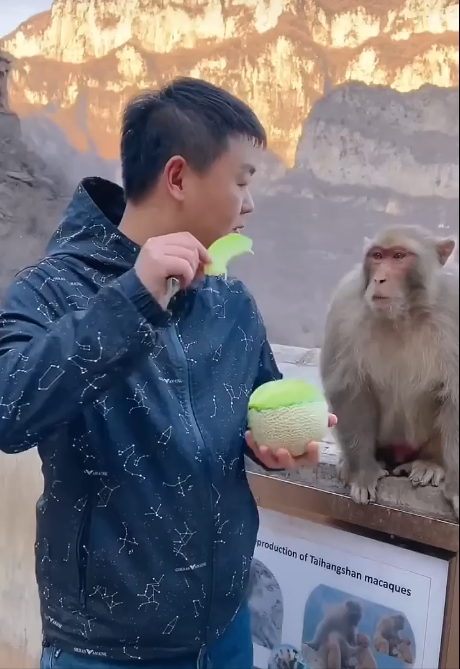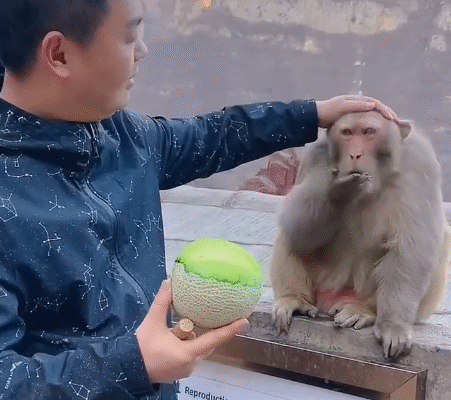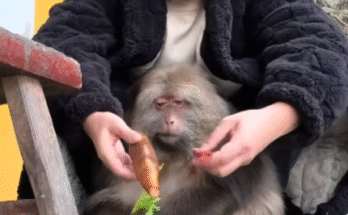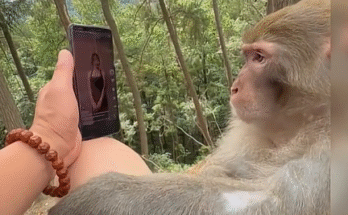
It was an unusually quiet morning in the monkey sanctuary. The early sunlight filtered through the tall bamboo groves, casting a golden glow over the ground where the monkeys played, groomed, and explored. Yet, amid the usual chatter and rustling of leaves, one little monkey stood out — Monkey Brother. He wasn’t his usual energetic, mischievous self. His tail twitched nervously, his small hands fidgeted with the leaves on the ground, and every sound seemed to make him jump. Something was bothering him, and it wasn’t long before the other monkeys noticed.
Monkey Brother had always been curious and playful, often the first to try new games or explore unfamiliar corners of the sanctuary. But today, he seemed anxious. He paced back and forth, muttering low grumbles, casting worried glances at the older monkeys and even the visitors peeking through the safety barriers. The troop had grown used to his antics — the pranks, the cheeky expressions, and the endless curiosity. But this nervous energy was something new.
Nearby, the elder monkeys observed him quietly, exchanging glances as if silently asking one another what could be troubling the younger one. They knew that Monkey Brother had always possessed a wild imagination, and sometimes it got the better of him. But there was something different today, a tension that even the seasoned troop couldn’t ignore.
It all started when Monkey Brother overheard the humans talking about a new enrichment activity — something called the “Monkey Challenge.” The caretakers described it in hushed tones as a playful experiment involving navigating narrow tubes, tunnels, and swings to reach hidden treats. For humans, it sounded fun. For monkeys, it sounded… complicated. Monkey Brother, being naturally imaginative, began to overthink. What if he got stuck? What if he fell? What if he couldn’t reach the treats? His little heart raced at the thought of failing.
As the monkeys moved through the sanctuary, Monkey Brother’s anxiety seemed to grow. He clung to branches higher than usual, avoided eye contact with the more confident monkeys, and even hesitated to play with his favorite toy, a small, colorful ball. He whispered to himself, pacing along the branch, muttering, “I can’t… what if it’s too hard… what if I….”
It was then that something remarkable happened. Whether it was his anxiety or his wild imagination running away with him, Monkey Brother began to “become” something entirely unexpected — in his mind, he transformed into a sperm. Yes, a tiny, super-fast sperm, darting through the vast universe of the sanctuary like a microscopic explorer.

In his imagination, the world around him changed. The leaves became towering green skyscrapers, the bamboo shoots were colossal pillars, and the streams that trickled across the ground became raging rivers. Monkey Brother zipped through the sanctuary with incredible speed, propelled by the boundless energy of his imagined form. He darted around obstacles, twisting and turning in midair, narrowly avoiding collisions with imaginary threats. The other monkeys looked on, puzzled, as Monkey Brother zipped past them with a wild expression, seemingly running away from something only he could see.
This imaginative transformation was not just a flight of fancy — it was his mind’s way of coping with anxiety. By imagining himself as something small, fast, and unstoppable, Monkey Brother could face the challenges of the day in a unique way. He became a hero in his own story, a tiny adventurer navigating a massive and intimidating world. His tail flicked rapidly, as if propelling him forward through this new realm, and his eyes sparkled with a mix of fear and excitement.
The troop watched in a mixture of amusement and concern. Elder Monkey, the wise leader of the group, approached cautiously. “Monkey Brother,” he said in gentle tones, “why do you run so? The world is not against you. You are strong, clever, and capable.” But Monkey Brother was too caught up in his imagined race to respond. He zipped past branches, swung from vines, and even attempted daring leaps from tree to tree, all within the protective confines of the sanctuary.
It wasn’t long before his imagination began to merge with reality. As he darted toward a narrow tunnel, he hesitated. In his mind, it was a perilous journey, a race to reach the goal against unseen forces. But in reality, it was just one of the enrichment tubes installed by the caretakers. With a deep breath, Monkey Brother launched himself forward, and to his surprise, he emerged on the other side unharmed, clutching a small treat that awaited at the end.
The transformation from anxious monkey to imaginative sperm had given him a unique edge. By thinking of himself as something fast, small, and unstoppable, he was able to overcome obstacles that might have seemed impossible before. His heart slowed, his tail relaxed, and a small smile crept across his face. He had succeeded. He had navigated the sanctuary in a way that only Monkey Brother, in his boundless imagination, could have achieved.
The other monkeys gathered around him, curious and intrigued. They sniffed his fur, nudged him gently, and even tried to mimic some of his daring moves. Monkey Brother, still a little breathless, realized something important: his anxiety hadn’t disappeared, but he had found a way to channel it. By letting his imagination take flight, he had turned fear into energy, hesitation into action, and doubt into creativity.

From that day forward, Monkey Brother became known as the little adventurer of the troop. Whenever he felt anxious, he would imagine himself transforming — sometimes into a tiny, super-fast sperm, sometimes into a flying acrobat, sometimes into a shadow moving unseen through the trees. Each transformation gave him courage and confidence, allowing him to face challenges with ingenuity and flair.
Caretakers and visitors alike began to notice this unique behavior. They marveled at how a monkey could turn anxiety into such an extraordinary display of creativity and agility. Photographers captured his daring leaps, playful sprints, and imaginative antics, and Monkey Brother became something of a legend within the sanctuary. But everyone who observed him also understood one thing: this was not a performance to be forced. It was a personal journey, a way for a young monkey to navigate the complex emotions of life, and a testament to the power of imagination.
By evening, the sanctuary settled into a calm rhythm. Monkey Brother, exhausted from his adventures, rested on a low branch, his tail twitching gently. The other monkeys curled up nearby, grooming and chatting softly. He looked out at the setting sun, reflecting on the day’s experiences. Anxiety still lingered, as it always would, but now he had tools, a way to cope and transform it into something beautiful.
Monkey Brother’s journey — from anxious little monkey to imaginative sperm, from fear to triumph — is a lesson for all creatures, human or animal. It reminds us that anxiety is not weakness; it is energy that, when channeled correctly, can fuel creativity, courage, and resilience. His story is a playful, whimsical reminder that even the smallest, most anxious among us can find extraordinary ways to overcome the challenges of life.
So the next time you see a little monkey pacing nervously or hesitating to leap, remember Monkey Brother. He shows us that imagination can transform fear, that courage can be found in the most unexpected forms, and that sometimes, becoming a tiny, unstoppable sperm — even just in your mind — can help you reach the heights you never thought possible.
Monkey Brother still lives in the sanctuary today, often caught mid-leap or darting through the bamboo, tail flicking with excitement and eyes sparkling with curiosity. And while visitors may see only a small, playful monkey, those who understand his journey know that they are witnessing something extraordinary — the triumph of imagination, courage, and the resilient spirit of a little monkey who refused to be defined by fear. 🐒💨



